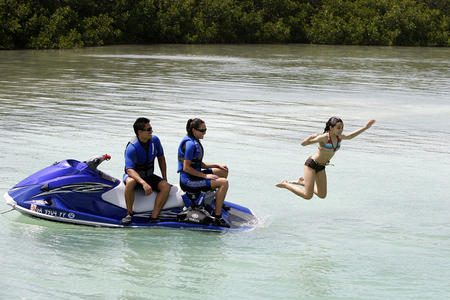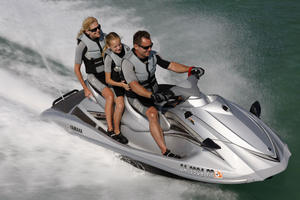2009 Yamaha VX Deluxe/VX Cruiser Review
A closer look at the best-selling watercraft on the market
Four-stroke personal watercraft changed, some would even rightfully argue saved, the PWC industry. Early four-strokes, however, were too expensive to truly grow the market. That’s why midway through the current decade, manufacturers were locked in a battle to produce the first ‘inexpensive’ four-stroke. Yamaha fired the first shot, introducing the VX Sport in late 2005. Since that day, VX-based models have been the best-selling watercraft in the industry each and every year they’ve been in production.
I recently took a closer look at the past year’s champ, the VX Deluxe, as well as the similarly equipped Cruiser edition (#3 on 2008’s hit parade), to see why these two boats continue to lead the industry.
Miss Popularities
So just how have two entry-level models become so incredibly popular? Obviously price is a consideration. When the VX 110 Sport was originally introduced in 2005, it was that long awaited, inexpensive four-stroke the manufacturers had long promised, but had yet to deliver. By making good on the promise, Yamaha proved not only that it could be done, but also that it could be done at a bargain price — $6,999. That not only made it the cheapest four-stroke model — by far — but also made it one of the cheapest PWC on the market period. It was big news then, and in many ways, it remains big news to this day.
What has truly set the craft apart over the years, however, is that it is simply a great personal watercraft. From the engine to the hull to the ergonomics, the VX is a good all-around boat, not some stripped-down blue-light special.
The 110hp mill under the seat is basically a tamer version of Yamaha’s MR-1 engine introduced with the FX series, the company’s first four-stroke models. A four-cylinder, 1052cc, 20-valve EFI that uses dual overhead cams, it’s a compact design that utilizes a one-piece cylinder and crankcase assembly that Yamaha claims is lighter and stiffer than conventional two-piece designs, while also proving more rigid. Like other variations on the MR-1, power is built through rpm, not displacement. Yes, that horsepower number is the lowest currently produced, but the craft still manages to run with its nearest competitor, Sea-Doo’s GTI SE 130. In numerous tests over the years I’ve seen it consistently average close to the 54mph mark, and 0-30mph times average around three seconds. No, it won’t blow any doors in a drag race, but that’s more than enough speed for most entry-level buyers, as well as those who simply desire to add another toy at the dock.
One upside to that tamer performance is industry leading fuel economy. Yamaha hyped this advantage in 2008, as gas prices skyrocketed. I confirmed the claim with an industry standard fuel-flow meter, noting a 4.1 gallon-per-hour burn at a comfortable 35mph cruising speed. Similar entry models burn from one-to-two gallons more per hour. Yamaha also put a unique twist on the boat’s key fob-activated low rpm mode last year, adding the obvious fuel-saving advantages to its conventional use as a way to tame the boat further for newcomers.
By Design
Yamaha houses that engine within what the company dubs a ‘progressive, stepper draft’ V-hull. Essentially a progressive V, it combines the necessary stability with surprisingly aggressive handling that, in true Yamaha fashion, remains always predictable. It’s the superior entry machine in rough conditions, steaming full speed ahead through the waves without getting pushed from its course. The downside is a slightly more jarring ride, but the impact is minimal. It’s also mostly dry, although the occasional splash will make its way over the bow.
Aft, you’ll find an oversized boarding platform. It offers a good place for skiers or wakeboarders to gear up, as well as those who take a spill to reboard. The deck, however, is slightly sloped, and lacks a boarding ladder. That can make it a little more hassle to clamber aboard. The boat uses a simple U-bolt for towing, which is functional, but basic compared to the standard tow eyes found elsewhere.
The Deluxe seat is contoured for three passengers, with a pair of gently raised bolsters to enhance driver and passenger comfort and security. The reverse setup is excellent in operation, but difficult to access. The console-mounted lever is located past the handlebars on the starboard side, requiring you to either forego throttle control, or perform a little Twister with your hands. Portside locations are much more practical.
Stowage is contained within a finished front tub area, along with a glovebox fitted with foam cupholders. Total storage capacity is 18.7 gallons. A pair of rearview mirrors are more functional than most thanks to the concave design of the glass, but I noticed the protruding location, far up the bow, makes them susceptible to damage at the dock.
Standard features include an information display that notes speed, fuel, and RPM and also tallies engine hours. The aforementioned remote control transmitter is used to lock the craft against unauthorized use, as well as activate the low rpm mode.
Let’s Cruise(r)
For an additional $400, the VX Cruiser is essentially the same boat but adds Yamaha’s popular cruiser seat, a comfortable, bolstered design that provides the most hip and back support of any current style. It combines with two other points of contact — the handlebars and chocked footwells — to provide a comfortable, almost laid-back positioning for long-distance touring. The Cruiser also adds a welcome flip-down reboarding step to make it easier to reboard the boat in deep water.
Both models have grown increasingly upscale over the years, despite their price tags. As Yamaha has discovered, the VX audience has grown far beyond so-called ‘entry-level’ buyers, and as such colors and finishes continue to evolve. The Deluxe, at $8,299, is offered in Neptune Blue and Eclipse Black. The Cruiser ($8,699) is available in both Eclipse Black and Platinum Metallic.
Bottom line? The VX Deluxe and VX Cruiser are best sellers for good reason. Both are solid, reliable, fun machines, with clean and quiet four-stroke technology, more than adequate performance and industry-leading fuel economy.
As the market has already indicated, that’s a tough combination to beat.
| Yamaha VX Deluxe/VX Cruiser Specs | |
| Length | 126.8 inches |
| Beam | 46.1 inches |
| Dry Weight | 710/712 lbs |
| Engine | Four-cylinder DOHC EFI |
| Displacement | 1,052 cc |
| Bore and Stroke | 76mm x 58mm |
| Compression Ratio | 11.4:1 |
| Rated Horsepower | 110* |
| Fuel Capacity | 15.9 gal. |
| Combined Stowage Capacity | 18.7 gal. |
| Colors | Neptune Blue, Eclipse Black (Deluxe), Eclipse Black, Platinum Metallic (Cruiser) |
| Price | $8,299 (Deluxe) / $8,699 (Cruiser) |
* Per company policy, Yamaha no longer publishes horsepower figures. The 110hp figure was documented before this policy went into effect.
Related Reading
2009 Yamaha WaveRunner Lineup
Get PersonalWatercraft.com in your Inbox!
Like PersonalWatercraft.com on Facebook
Comments
Most Popular

2025 Yamaha JetBlaster PRO 2-Up Review

2024 Kawasaki Jet Ski STX 160X Review

Remembering the Sea-Doo XP

Whatever Happened to the Wetbike?

2025 Yamaha JetBlaster Review

















 Your Privacy Choices
Your Privacy Choices